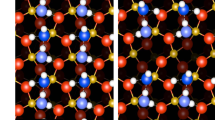Abstract
In this article, a theoretical analysis of the behavior of metallic materials at high temperature in the presence of gaseous oxygen is presented. A generalized Wagner approach is presented in the limiting scenario of highly reactive vapors, Wagner’s theory being the lower limit for null reactivity. Oxygen transfer from the gas phase to the condensed phase is expressed in terms of oxygen effective pressure, accounting for the contribution of volatile oxides. The theoretical approach allows the prediction of the oxygen partial pressures in the feed gas corresponding to oxidation/deoxidation conditions. Such conditions can be different from those given by thermodynamic equilibrium by several orders of magnitude. Moreover, the actual oxygen partial pressure at the condensed phase interface can be expressed as a function of the feed-gas oxygen content, which is measurable. The theory is applicable for metals and nonmetallic materials, such as semiconductors, both in solid and liquid phase. An application to the molten silicon-oxygen system is presented.
Similar content being viewed by others
Abbreviations
- c i :
-
concentration of the ith compound, mol cm−3
- d d :
-
metal sample characteristic dimension
- D :
-
diffusivity, cm2 s−1
- f j :
-
function (of T and c i) in the reaction kinetics expression of the jth oxide
- k :
-
constant common to all reaction kinetics, cm3 mol−1 s−1
- K pj :
-
equilibrium constant for the jth reaction
- K j :
-
dimensionless equilibrium constant for the jth reaction
- K s j :
-
saturation product for the jth oxide, defined as P s Cj /K pj
- I :
-
inert gas (He, Ar, ...)
- n :
-
total number of oxides
- n i :
-
dimensional molar flux
- N i :
-
molar flux, mol cm2 s−1
- P i :
-
partial pressure, atm
- r i :
-
reaction rate of the ith compound, mol cm−3 s−1
- Re d :
-
Reynolds number of the metal sample.
- x i :
-
concentration of the ith chemical specie, normalized with respect to c s B
- X A :
-
dimensionless total effective oxygen concentration
- X B :
-
dimensionless total effective metal concentration
- y :
-
molar fraction in the condensed phase
- z :
-
spatial coordinate with origin at the interface and perpendicular to it, cm.
- α j :
-
oxygen stoichiometric coefficient in the jth oxidation reaction
- ζ :
-
dimensionless spatial coordinate with origin at the interface and perpendicular to it
- δ :
-
diffusive layer
- Φ:
-
Thiele modulus
- Ψ:
-
diffusivity, normalized with respect to D A
- 0:
-
carrier gas
- σ :
-
metal surface
- s :
-
saturation
- *:
-
equilibrium with the condensed phase
- i :
-
index for all chemical species, A, B, C j
- j :
-
index for oxides
- p :
-
index for the oxide with minimum solubility product
- eff:
-
effective pressure
- —:
-
in the liquid phase
References
C.H.P. Lupis: Chemical Thermodynamics of Materials, Elsevier Science Publishers, New York, NY, 1983.
E.T. Turkdogan, P. Grieveson, and L.S. Darken: J. Phys. Chem., 1963, vol. 67, pp. 1647–54.
C. Wagner: J. Appl. Phys., 1958, vol. 29, pp. 1295–97.
K. Nogi, K. Ogino, A. McLean, and W.A. Miller: Metall. Trans. B, 1986, vol. 17B, pp. 163–70.
Z. Niu, K. Mukai, Y. Shiraishi, T. Hibiya, K. Kakimoto, and M. Koyama: Proc. Int. Conf. “High Temperature Capillarity,” N. Eustathopoulos and N. Sobczak, eds., Krakow, Poland, 1997, pp. 175–81.
A. Passerone, E. Ricci, and R. Sangiorgi: J. Mater. Sci., 1990, vol. 25, pp. 4266–72.
E. Ricci, A. Passerone, P. Castello, and P. Costa: J. Mater. Sci., 1994, vol. 29, pp. 1833–46.
P. Castello, E. Ricci, A. Passerone, and P. Costa: J. Mater. Sci., 1994, vol. 29, pp. 6104–14.
V. Laurent, D. Chatain, C. Chatillon, and N. Eustathopoulos: Acta Metall., 1988, vol. 36, pp. 1797–1803.
E. Ricci, M. Ratto, E. Arato, P. Costa, and A. Passerone: Iron Steel Inst. Jpn. Int., 2000, vol. 40, pp. S139-S143.
M. Ratto, E. Ricci, and E. Arato: J. Cryst. Growth, 2000, vol. 217, pp. 233–49.
E. Ricci, L. Nanni, E. Arato, and P. Costa: J. Mater. Sci., 1998, vol. 33, pp. 305–12.
E. Ricci, L. Nanni, and A. Passerone: Phil. Trans. R. SoC. London, 1998, vol. A356, pp. 857–70.
C. Gelain, A. Cassuto, and P. Le Goff: Oxid. Met., 1971, vol. 3, pp. 139–51.
E.A. Gulbransen and S.A. Jansson: Oxid. Met., 1972, vol. 4, pp. 181–201.
E.A. Gulbransen, K.F. Andrew, and F.A. Brassart: J. Electrochem. Soc., 1966, vol. 113, pp. 834–37.
P.D. Agnello and T.O. Sedgwick: J. Electrochem. Soc., 1992, vol. 139, pp. 2929–34.
E. Ricci, R. Novakovic, E. Arato, M. Ratto, and A. Passerone: E.L.G.R.A. News, 1999, vol. 21, p. 117.
R.B. Bird, W.E. Stewart, and E.N. Lightfoot: Transport Phenomena, John Wiley & Sons, Inc, New York, NY, 1960.
J.R. Engstrom, D.J. Bonser, M.M. Nelson, and T. Engel: Surface Sci., 1991, vol. 256, pp. 317–43.
O.E. Kashireninov: in Gas-Phase Metal Reactions, A. Fontijn, ed., Elsevier Science Publishers, New York, NY, 1992, pp. 621–42.
B.J. Keene: Surf. Interface Analysis, 1987, vol. 10, pp. 367–83.
H.J. Leamy and J.H. Wernick: MRS Bull., 1997, May, pp. 47–55.
O. Knacke, O. Kubashewski, and K. Hesselmann: Thermo-Chemical Properties of Inorganic Substances, II ed., Springer-Verlag, Verlag Stahleisen mbH, Düsseldorf, 1991.
X. Huang, S. Togawa, S.-I. Chung, K. Terashima, and S. Kimura: J. Cryst. Growth, 1992, vol. 156, pp. 52–58.
Author information
Authors and Affiliations
Rights and permissions
About this article
Cite this article
Ratto, M., Ricci, E., Arato, E. et al. Oxidation of metals with highly reactive vapors: Extension of wagner theory. Metall Mater Trans B 32, 903–911 (2001). https://doi.org/10.1007/s11663-001-0076-9
Received:
Issue Date:
DOI: https://doi.org/10.1007/s11663-001-0076-9




